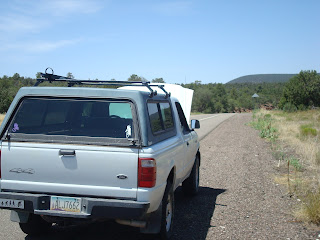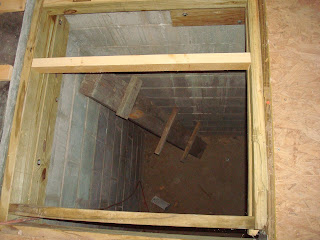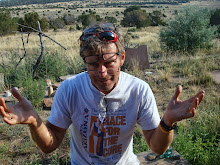The smell of coolant came as no surprise. I had just
climbed out of the Salt River Canyon and my little pick-up truck was straining
to ascend the steep inclines of Arizona’s Central Highlands. The fan had been groaning and shaking whenever the motor wailed in high RPMs. Likely the water pump was going out, but I did not want to think about it. In fact I refused to think about it. Never, as they say, underestimate the power of self-distracting denial.
I had been singing to myself – my usual sad and soulful travel fare: "Sixteen Tons" by Tennessee Ernie Ford, "Ring of Fire" as sung by Johnnie Cash, some Doc Watson standards, and, just to mess with the old boys, Melissa Etheridge – when on about the third refrain of "Come to my Window" when the smell hit me.
I had been singing to myself – my usual sad and soulful travel fare: "Sixteen Tons" by Tennessee Ernie Ford, "Ring of Fire" as sung by Johnnie Cash, some Doc Watson standards, and, just to mess with the old boys, Melissa Etheridge – when on about the third refrain of "Come to my Window" when the smell hit me.
Now, the mountains between Globe and Show Low are
not tall by mountain standards, but are steep, each ending only to begin climbing
the next. They have a way of killing cars. Not once, but twice, cars have died at the crest of a pass, south of Globe. I know the risks of driving old cars in the summer in these parts.
This time, I was on my way home from New Mexico, north of Globe when the steam began rising from the hood. I was hoping to make it home to Tucson before the water pump gave up the ghost, but no such luck.
This time, I was on my way home from New Mexico, north of Globe when the steam began rising from the hood. I was hoping to make it home to Tucson before the water pump gave up the ghost, but no such luck.
I had to cut Melissa, check the mirror, and pull
over on the shoulder. I didn’t know if the singing had caused the failure or the
mountains. I guessed it didn’t matter. What did matter was that I was hobbled in
the middle of Arizona on some crest of the rolling mountains on the San Carlos Apache Indian
reservation.
It was windy and hot as I peered under the grill and
saw my coolant generously dripping on the gravel. When I lifted the hood I got
a dose of toxic fumes. Yup, coolant. Not good.
Being at a high point of one the many mountains, I hoped
for cell phone service. No luck there either. I have broken down on this trip between
low and high desert before, so I knew it was going to be a long day.
These trips have been a "between time," time when I fall out of my routine and consider my life's trajectory. I suspend habits and head out somewhere -- a canyon like Cibique, where waterfalls carve deep pools in the dark between canyon walls, or the open meadows of the White Mountains. On the way, I reflect on questions like Where am I going? What am I doing with my life? How far is it to the espresso bar?
This time was no different and just because I had stopped did not end the questions. But reality is more immediate when the show-as-planned comes to a halt. A strange and terrifying thing happens as I slip back to the here and now that has become the betwixt and between, as in the middle of nowhere, between edges of somewhere.
My stomach was raw with the coffee I had been drinking. I did not have any food, but did find a nice juniper to hide myself when I followed the radiator's example.
I also took stock: water? check (one liter); food? negatory; air? great; sky? superb; brain? re-engaging.
These trips have been a "between time," time when I fall out of my routine and consider my life's trajectory. I suspend habits and head out somewhere -- a canyon like Cibique, where waterfalls carve deep pools in the dark between canyon walls, or the open meadows of the White Mountains. On the way, I reflect on questions like Where am I going? What am I doing with my life? How far is it to the espresso bar?
This time was no different and just because I had stopped did not end the questions. But reality is more immediate when the show-as-planned comes to a halt. A strange and terrifying thing happens as I slip back to the here and now that has become the betwixt and between, as in the middle of nowhere, between edges of somewhere.
My stomach was raw with the coffee I had been drinking. I did not have any food, but did find a nice juniper to hide myself when I followed the radiator's example.
I also took stock: water? check (one liter); food? negatory; air? great; sky? superb; brain? re-engaging.
There was a cement mixer parked down a ways across
the highway at one of the big pullouts. The motor was running, though I could
see no one in the cab. I waited for a break in the nonexistent the traffic (why hurry things?) and made my way to
the truck, monitoring my phone to see if I could pick up a signal. It's hard to give up cell phone hope, after all. I noticed a
mile marker tried to figure out exactly where I was. My phone was useless; as
help it offered up only “emergency calls only” again and again. Yes, just the way I like it, but I can't give up that easily. Habits die hard.
It looked like the driver of the cement mixer was
taking a nap, so I did not knock or try to get his attention.
I kept trying to pick up a signal, but the bars went
away as soon as I tried to call. Just as I headed back to the truck the driver
opened the door and climbed down from the cab. He looked worried, sympathetic, like something dangerous was stalking us. Being outside on a remote stretch of Arizona highway is fraught with equal parts peril and potential. Most of us want to keep the time as short as possible. He wanted to get me out of there quick.
He did have a phone and a couple of bars of service. He dialed the number of a Globe tow truck and then passed the phone over to me. I gave the dispatcher the particulars, mile marker 282, south of the Salt River Canyon, north of Globe about twenty miles.
He did have a phone and a couple of bars of service. He dialed the number of a Globe tow truck and then passed the phone over to me. I gave the dispatcher the particulars, mile marker 282, south of the Salt River Canyon, north of Globe about twenty miles.
She said she would send a driver soon.
The driver of the cement mixer took back his phone,
climbed in the truck and said he was headed up toward Kayenta, a long drive in a big truck, a rolling capsule of protection, safety. Or a cage, depending on how you look at it.
I offered him ten dollars, but he declined and put
the big truck into gear. "Like money is going to do any of us any good out here," he said.
I went back to the juniper to recycle some more minerals, to liberate the Show Low coffee, to do my part to keep the high pigmy desert scrub happy and healthy all while enjoying my role in the big scheme, one of the great benefits of being far from somewhere. Then back to the truck to think and wait.
When all else fails, I say write. I pulled out my journal
and began scratching some philosophical attempts at making sense of the situation. "Here I am, free to make something of this open, surprising, and unscheduled moment. What a thing. I don't quite know what to do with it and notice that I am anxious to get out of it. Why is that?"
A pick-up traveling the other direction noticed me scrunching up my face at these conundrums, and took pity on me, slowed, did a U-turn and pulled up beside me, in four wheel drive, jauntily tipped by the slope of the ditch between us.
A pick-up traveling the other direction noticed me scrunching up my face at these conundrums, and took pity on me, slowed, did a U-turn and pulled up beside me, in four wheel drive, jauntily tipped by the slope of the ditch between us.
"You alright?" asked a man with a cowboy hat, an intent to do good, and
some kind of badge. His look said I needed company, to be brought back into the fold of humanity, that I should not be out here alone between all the safe and busy zones of productivity and directed behavior. But he knew something too. He was between places too, had some secret taste of the between places way of being.
"I’m good. Got some water. Waiting for a tow truck."
I saw his face relax a bit. Good, I could hear him saying to himself, this guy is not yet gone too far into the between. He is still social, is shaved, has not gone too far into the wild world of nothing and nowhere. He had been there too I could see, but did not stay long.
I saw his face relax a bit. Good, I could hear him saying to himself, this guy is not yet gone too far into the between. He is still social, is shaved, has not gone too far into the wild world of nothing and nowhere. He had been there too I could see, but did not stay long.
"Well, you know, my dad used to drive all us kids up
this road, and one time we broke down at night – six of us in one of those old
Pintos. I can't quite explain it, but I remember that time. We all felt, so.... close, I guess." At this point he looks at me like he has gone too far, into a topic best left private. He quickly jumps to the happy ending. "A couple of drunk guys in a panel van gave us all a ride to Show Low.
Since then I always stop if I see a car in trouble. Wouldn't want anybody stranded out here too long, in the middle of nowhere. Who knows what might happen?"
Yeah, I think to myself. Who knows what might happen? Exactly. Obviously. Too-close-for-comfortly.
Yeah, I think to myself. Who knows what might happen? Exactly. Obviously. Too-close-for-comfortly.
We talked some more about being between places and how that can color one's view of the world. For him, the road and the moments of possibility created by being stuck and stranded had been generous. I can't say it's that way for everyone, and that may be why it is so frightening to be cast out of routine and into a moment that must be made up, on the spot, no script. Scary.
As he pulled off, made his turn and continued on his way, I sat with this mildly terrifying gift of time I had been given, and kept writing.
As he pulled off, made his turn and continued on his way, I sat with this mildly terrifying gift of time I had been given, and kept writing.
"My life seems to slipping from my control,” I
wrote, "but that is not necessarily a bad thing. I don't know what is going to happen next. I feel curious, a bit excited and alert. I am off my course wondering how this detour will affect my memory of this day, this place, this gap filled to the brim with potential."
"Who knows what will happen in these next moments
waiting by the road for a tow truck that may have gone the wrong direction for
all I know? Strange, to feel so free, here not quite at home, but a welcome guest, between places.
Hallelujah! I am in the gap, the interstice, the living, fully-charged nowhere between things. What potential!"
Gulp!
Hallelujah! I am in the gap, the interstice, the living, fully-charged nowhere between things. What potential!"
Gulp!








